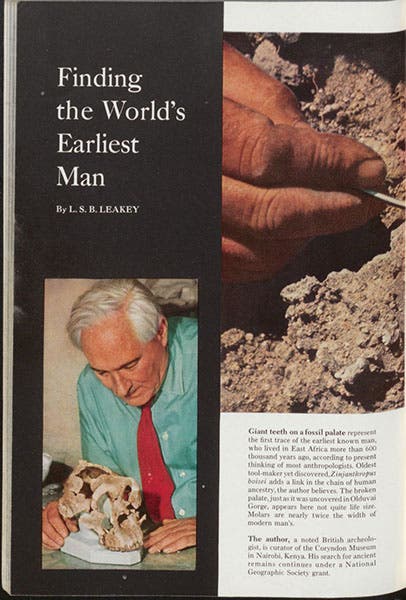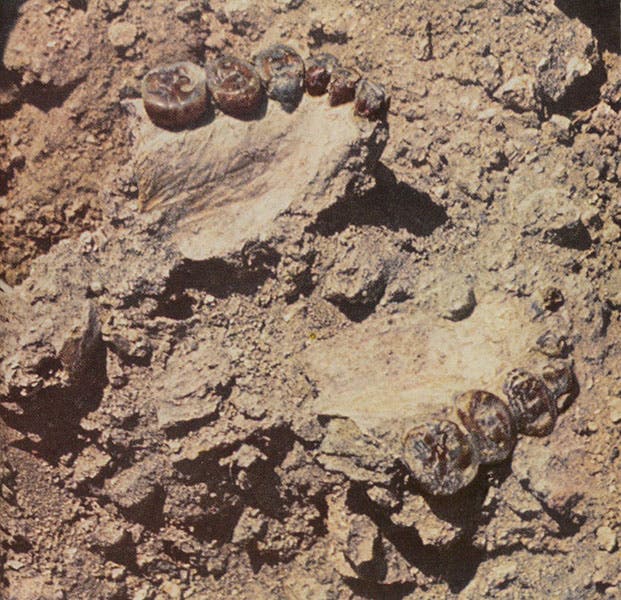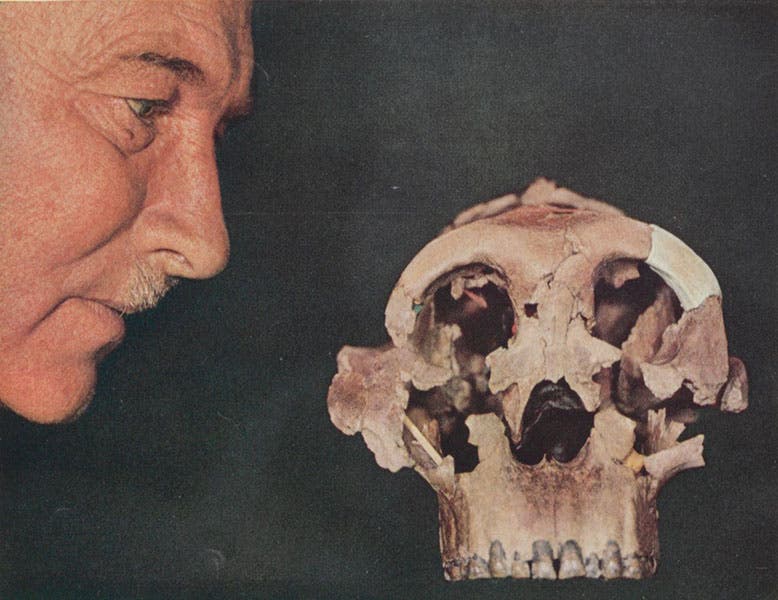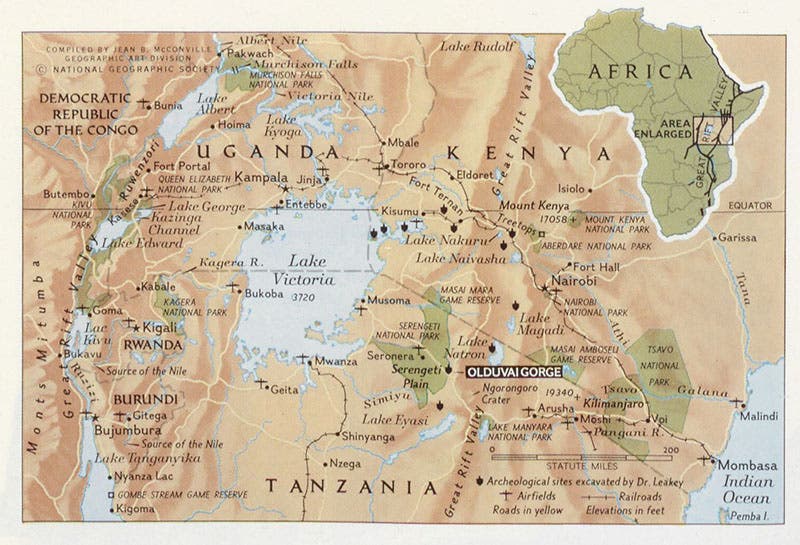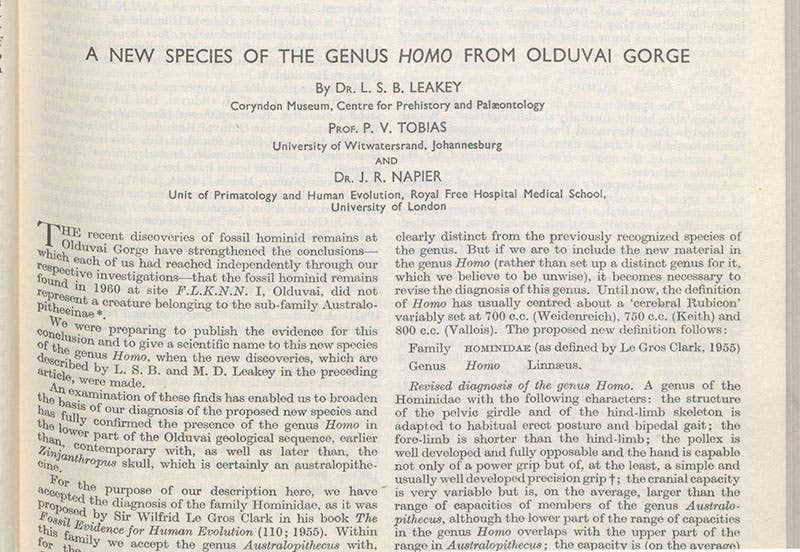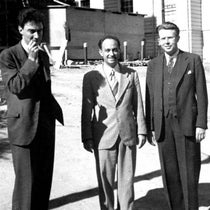Scientist of the Day - Louis Leakey
Louis S.B. Leakey, an African-born English anthropologist, was born Aug. 7, 1903, in Kabete, Kenya. His parents were both Anglican missionaries in East Africa, and Leakey’s upbringing was missing such amenities as wooden floors, toilets, and running water, which was probably good preparation for his future career as a field archaeologist. He returned to England for his higher education, attending Cambridge; it is said that when he took his orals, where he had to show proficiency in another language besides English, he chose Swahili (or perhaps Kikuyu – accounts differ; Leakey spoke them both fluently).
Leakey's first marriage did not last long, as he soon had an affair with a young illustrator, Mary Nicol. They would marry in 1936, once he obtained a divorce from his first wife. In 1931, Louis made his first investigation of Olduvai Gorge, just across the Kenya border in Tanzania, where he found primitive tools, but no hominid fossils. He returned there with Mary many times, as she became director of excavations at the site, while Louis presided over the museum in Nairobi. By the 1950s, they had collected hundreds of primitive stone tools, choppers that are now designated as Oldowan tools, but Louis desperately wanted to find fossils of the hominids who made those tools.
Their first success came in 1959, when Mary discovered a fragmented hominid skull, which Louis named Zinjanthropus boisei. We told some of this story just three weeks ago, when we celebrated the anniversary of the discovery of Zinjanthropus on July 17. Zinj was a fine specimen, but he clearly was not the tool maker that Louis was looking for. But he did solve a lot of problems for Louis, for Zinj attracted the attention and the financial support of the National Geographic Society, a real boon for their excavations, which were perpetually short of cash. The story of Louis and Mary Leakey and the discovery of Zinj was announced to millions of subscribers in September 1960, when an issue of National Geographic was published with a 15-page spread on the Leakeys. Louis now had not only financial support, but fame. Unlike Mary, he found that he loved the attention, the limelight, the applause. He began to make annual trips to the United States to raise funds, especially to southern California, where he was treated almost like a god. He was, by 1965, the most famous anthropologist in the world, and perhaps the most famous who had ever lived.
But he still wanted to find the Oldowan toolmaker. Mary and their oldest son Jonathan had discovered at Olduvai fragments of a skull and some limb bones that clearly did not belong to relatives of Zinj, and more pieces turned up between 1960 and 1963. Leakey decided that all came from one species, and he estimated the cranial capacity (size of the brain) to be around 600 cc, large enough to be both human and a toolmaker. That was enough for Louis; in 1964, he and two colleagues announced that they had their toolmaker. He named it Homo habilis – “handy man” – a name suggested by Raymond Dart, who had found (and named) the first Australopithecus forty years earlier (an alternative designation for the holotype is OH 7, short for Olduvai Hominid 7). The announcement was published in Nature (one did not name a new species in National Geographic), but the magazine soon published their own article on Homo habilis. It contained the now iconic photo of Louis with a pocket full of fossils (first image), and an excellent map of East Africa, including Olduvai Gorge.
Homo habilis as a species was controversial at first, but it was eventually accepted, especially as new specimens turned up, many of them found by the Leakeys’ second-oldest son Richard, who would rapidly overtake his father and mother as a hominid fossil hunter. Louis began to suffer physical problems around 1968, and he and Mary drifted apart, as Louis courted acclaim in America, and Mary searched out new fossil sites at places like Laetoli. Louis died on Oct 1, 1972, in London, of a massive heart attack. He was 69 years old. His body was flown back to Kenya, and he was buried in Limuru in a lovely pastoral cemetery (eighth image).
Since Louis Leakey was essentially “Mr. National Geographic” throughout the 1960s, we decided to illustrate this post with images that first appeared in that magazine. The photo of Louis and Mary that we used in our post on Zinj also came from the September 1960 issue of National Geographic. The only exception is the seventh image here (just above), showing the fragments of the holotype of Homo habilis, which was taken by the gifted anthropological photographer, John Reader, and the photo below of the gravesite.
William B. Ashworth, Jr., Consultant for the History of Science, Linda Hall Library and Associate Professor emeritus, Department of History, University of Missouri-Kansas City. Comments or corrections are welcome; please direct to ashworthw@umkc.edu.



